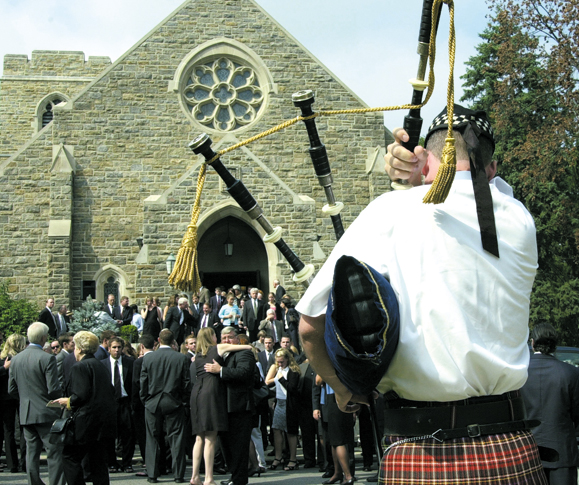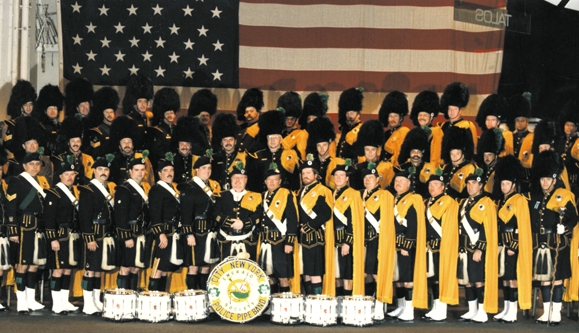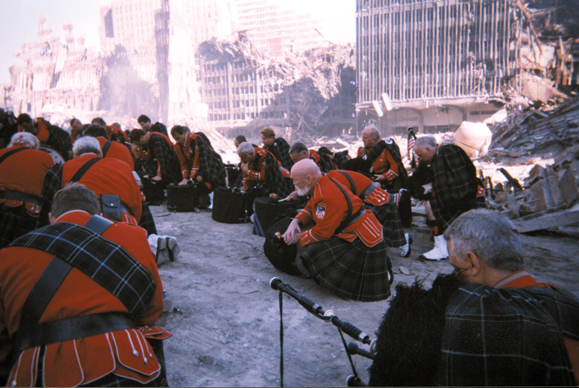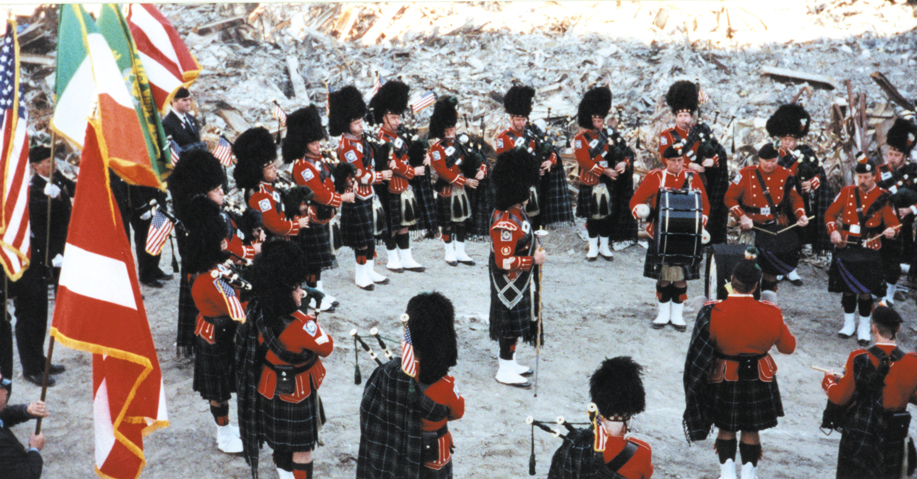The Pipes and Drums Bands of the Fire and Police Departments were on hand to plat a final farewell to colleagues.
In the past, New York has had many happy associations with the sound of bagpipes, including the rousing jubilation of the bands marching up 5th Avenue on St. Patrick’s Day. The tragically high number of fatalities amongst the police and fire departments — 343 in the FDNY, 23 in the NYPD and 37 in the PAPD — has meant that henceforth for many people, the sound of bagpipes and the roll of drums will be evocative of funerals and memorial services.
The FDNY, NYPD and the PAPD (Port Authority Police of New York and New Jersey), each has its own pipes and drums band which spent the four months following the attacks in a constant blur of funerals and memorial services throughout New York and New Jersey. The FDNY’s band has already played at more than 300 with the prospect of more to come (some families having chosen to defer a funeral/memorial service until their loved one’s body can be found), while the PAPD band played at over 40 and the NYPD at over 20.
Steve Butterbrodt, a Port Authority veteran of 28 years who has been in the band for over 20 years, recalls how difficult it was to play at the funerals of his fallen friends. “It was so hard, trying to distance yourself to get through it — we were very close. Whenever anybody dies in the line of duty, you feel the loss but when you work with them and it is someone you have just been with or just spoken to, it’s really tough.”

The NYPD band lost Steve Driscoll, a color guard (standard bearer) member and played first at his memorial service and again at his funeral. The FDNY band lost Durrell “Bronko” Pearsall, a drummer who worked in Rescue 4. Joe Murphy, a Fire Department veteran of 20 years, who is chairman of the FDNY band explains, “He was one of us, we played together, practiced together and took trips to Ireland, Scotland and Germany together. They found his body a week before the scheduled memorial service so at least we were able to give him a good send-off at St. Patrick’s Cathedral.” He adds, “All funerals are sad — to see the widows and mothers with that numb look of sorrow — you pretty much feel their pain…but when you know the person yourself, it’s intensified.”
Another loss keenly felt by the FDNY’s band was that of Fr. Mychal Judge who, as well as being chaplain of the Fire Department, was chaplain to the band. He was an honorary member of the band and is much-missed. “He was a good friend to all of us as well as being chaplain. We presented him with a kilt which he wore to all our parties. He was an amazing guy,” says Murphy.
All three bands were established by branches of the Emerald Society, a society which promotes Irish heritage and culture across the United States. To become a band member, one had to be a member of the Emerald Society, which has its own membership criterion of having Irish ancestry. This requirement proved to be unduly restrictive for a smaller organization like the PAPD which doesn’t have as much Irish blood to draw on as the NYPD and FDNY. About 10 years ago, the PAPD band was having trouble recruiting members until it opened up membership to non-Irish pipers and drummers by severing its association with the Emerald Society. Nevertheless, the band retains a strong Celtic flavor in the music it plays and like the other bands is much sought after for marches, parades, weddings and other local or social events.
While the Emerald Society bands of the NYPD and FDNY still require some degree of Irish ancestry, they will and do play for anyone, regardless of denomination or background.
In the Celtic tradition, it is the haunting sound of a lone piper and not the collective wail of a band of pipers and drummers that accompanies the funeral procession to the graveside. The pipes and drums band of the Emerald Society’s NYPD branch claims the distinction of having started the tradition of bands playing at funerals in this country. According to bandmaster Sergeant John Tansey, who has been on the force 39 years and has been bandmaster for 22 years, the tradition dates back only as recently as 1971.
“In 1971, we lost Patrick O’Connor, a band member, in the line of duty — 7,000 police officers attended the funeral and it was the first time they saw a police band come out in tribute to a fallen colleague. We caused the proliferation of police pipe bands — we like to feel it is part of our legacy.”

The NYPD band was the first of the Emerald Society pipes and drums bands. It first marched up 5th Avenue on St. Patrick’s Day in 1960, the year it was established, and currently has 68 members.
The FDNY’s pipes and drams band can claim almost as much longevity. Their band was founded in January 1962 and has 70 members.
The PAPD band today has 23 members. Prior to September 11, it had 21 but tragically on that day lost three drummers — Drum Sergeant Liam Callaghan, Snare Drummer Richie Rodriguez and Bass Drummer Steve Huczko. A recently graduated class has brought renewed interest and five new members to the band so that it is now actually bigger than it was before September 11.
What is striking about all the bands is the strong sense of fraternity that seems to exist between the members. To a layman, the sense of brotherhood amongst police officers and firefighters has always seemed remarkable but there seems to be an especially deep bond between the band members — brought about perhaps by the sacrifices that membership in the bands entails.
Being a member of a pipe and drum band requires a serious amount of commitment. Although some retired cops and firemen remain with the band, most members are working men who combine demanding careers as firefighters or police officers with family life. On top of their busy schedules they choose to put in one evening a week practicing and maybe another day or two performing.
In a normal year, a band might play up to 170 performances — not every band member will need to turn out for every performance, but still the demands on one’s time are significant. The police band’s John Tansey believes that not everybody is cut out for it. “If we were to actively try to recruit members, we would get 350 applicants but we have to pick and choose, some just aren’t able for whatever reason to make the commitment.”
According to the PAPD’s Butterbrodt, the pressures on a smaller band of attending the funerals combined with 12-hour shifts for most of their members meant that they weren’t able to hold a formal practice session for four and a half months after September 11th. “With the 40 funerals (some we did twice, because we did a memorial service and then we did the funeral) we haven’t had the time to practice. We have practices scheduled and hope to get back and try to get ready for competitions then and get ready for St. Patrick’s Day”
The sense of brotherhood extends across the professional barriers and into the “competing” bands. The Fire Department’s Murphy says that this is because many Irish-American families have members in the fire, police and Port Authority departments. “Families and friends and neighbors who live side by side — some are in the police force, others are in the Fire Department. When we were doing eight to ten funerals a day — at weekends it would be up to twenty — the police band helped us out with a number of funerals.” The Police Department’s Tansey, whose grandfather was a firefighter and who has two nephews who are firefighters corroborates this. “We come from the same stock, we’re the same people.”

The Port Authority’s band was helped by other bands in Jersey who swelled their numbers. “The United Jersey bands came out to help us — we had great turnouts — fifty to sixty band members at each funeral.”
Despite the appalling tragedy and losses of the last year, the bands are optimistic about the future and, like the departments themselves, are trying to put this intensely sad period of mourning and funerals behind them. The Fire Department was by far the worst hit in terms of loss of life, but while Murphy says “it is never going to be over — their loved ones are gone so now we have to look after the widows and children,” he adds that “we are trying to move forward and look to the future.”
The FDNY’s band is planning a trip to Ireland in July. About 20 members and their families will visit Kilkenny for the All-Ireland Pipes and Drums Championships. They don’t know yet whether they will enter the competition or not — their schedule since September 11th has left them no time to practice their competition music. But if they are not ready, it is hardly important — they will go anyway and hopefully get in a little bit of playing alongside forging new friendships and having some much deserved fun.
Proving that the sense of brotherhood between firefighters even extends across oceans, they will also visit the Dublin Fire Brigade’s band with whom they have a strong bond of friendship and who will be coming over to march in the St. Patrick’s Day parade in New York. They will be celebrating their 40th anniversary in May 2002 with a dinner dance at Antun’s in Queens.
Tansey feels that interest in the NYPD band has never been stronger. “We were already a tight bunch, but if it was possible to make us even closer, then September 11 has done that. The rhythm of the band is great — members in their twenties get along with members in their seventies. It’s a great club to belong to, and people recognize that.”
Butterbrodt too believes that the future for the PAPD’s band is bright. “Since September 11th, there has been an increased interest. When we went out for our funerals and the United Jersey bands came out too, it really opened the eyes of the younger recruits. They saw what we were here for and wanted to be part of it.” ♦


Leave a Reply